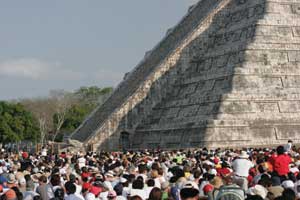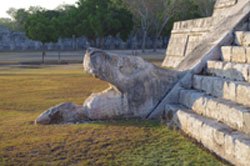The Descent of K'uk'ulkan
Hundreds of people stand gathered in front of an ancient Maya pyramid temple, waiting for the Sun to drop lower in the sky. On this special day – a day of equal hours of light and darkness – it is said that the great feathered serpent god K’uk’ulkan will descend from the sky, slither down the enormous pyramid and energize the earth. A sense of excitement shivers through the crowd as the top-most of the pyramid’s platforms begins to cast a shadow on the northwestern staircase. Spellbound, people watch as the shadow creeps lower, creating the effect of a serpent of light moving down the staircase. At last, the stone serpent head at the base of the pyramid is illuminated by the Sun and the crowd breaks into cheers.

Crowds gather at El Castillo to witness the equinox light and shadow effect. (Image credit: Jim Spadaccini, Ideum)
For the Maya in the ancient city of Chichen Itza, the building we call today the Temple of K’uk’ulkan (el Castillo de K’uk’ulkan in Spanish) marked the days of the year. In designing the structure, Maya architects drew on astronomical knowledge of the Earth’s annual journey around the Sun. The temple itself sits on top of a four-sided pyramid built out of nine platforms. Each side of the pyramid has a monumental staircase with 91 steps. When the top step that is common to all four staircases is counted, there are a total of 365 steps representing the days of the year. The Maya divided the year into 18 months, which are represented on the temple in 18 panels.
Like many cultures around the world, the Maya watched the movements of the Sun carefully and knew about the solstices and equinoxes. As the Earth spins on its axis every 24 hours, it also moves in space around the Sun in one year. Because the Earth’s axis is tilted 23.5° relative to the plane of its path around the Sun, some days of the year have longer hours of light than others. The winter solstice is the shortest day of the year, while the summer solstice is the longest day of the year. On the equinoxes, there are equal amounts of light and darkness.
People who live in high latitude locations tend to celebrate the solstices as important days of the year because there is a large difference between the lengths of day at winter solstice compared to summer solstice. If you lived at 51° North latitude, you would have 8 more hours of daylight on the summer solstice than on the winter solstice. This dramatic difference in length of day has profound effects on the seasons and agricultural cycles. It makes sense that people at this latitude would build monuments, such as Stonehenge, that are aligned with the solstice Sun.
Because Chichen Itza lies much closer to the Equator, there is less change in length of day between the summer and winter solstices. At 20° North latitude, people at Chichen Itza have only approximately one more hour of daylight at summer solstice than at winter solstice. Since length of day is related to seasons, Chichen Itza effectively has two seasons instead of four. For the Maya, the March equinox is an important marker of the transition time between the wet season and the dry season.
In lowland Maya areas such as Chichen Itza, the wet season runs from approximately late April or early May through early November. The March equinox indicates the time to observe a new beginning in the agricultural cycle. It is a signal to farmers to start clearing their fields in preparation for planting corn. Farmers will slash and burn the land to provide ash that nourishes the soil. When the rains come, these fires are extinguished.

Maya man harvests corn in a basket carried on his back. (Image Credit: Alfredo Escalante Galaz)
The rains coincide with another important celestial event, the zenith passage of the Sun. Many people think that the Sun passes directly overhead everyday at noon, but that is not true. In fact, it is only at tropical latitudes (between 23.5° North and 23.5° South latitude) that the Sun travels through the point that is 90° from the horizon. At tropical latitudes, the zenith passage of the Sun happens only two days of the year. When the Maya today notice the shadows of vertical objects “disappear,” as shadows do at the first zenith passage of the Sun in May, they know it is time to start planting.
As the months go by, other celestial markers guide the agriculture cycle. When the bright star Sirius rises just before dawn in early August, Maya farmers know that a dry spell is coming and they should prepare to dry the corn. The end of the wet season is marked by the nadir passage of the Sun – the time when the Sun travels through the point directly opposite the zenith.
The March equinox celebration at the Temple of K’uk’ulkan connects this astronomical knowledge and agricultural practices with mythology. K’uk’ulkan is one of the Maya creator gods who is usually pictured as part snake and part bird. There are various ways of spelling the god’s name, each one having a slightly different meaning. One way of interpreting the god’s name is “K’u” meaning god or sacred, “k’ul” meaning coccyx or vibration and “can” meaning serpent. According to some Maya elders, the seven lighted and six dark triangles formed on the staircase of El Castillo pyramid in Chichen Itza on the equinox represent the seven days and nights of creation. The sum of these lighted and dark triangles represent the 13 levels of heaven in the Maya concept of the world. Similarly, the nine platforms of the temple represent the nine levels of the underworld.

Serpent head at the base of the staircase, Temple of K'uk'ulkan, Chichen Itza. (Image credit: Bryan Mendez, UC Berkeley)
Not everyone agrees that this temple was dedicated to K’uk’ulkan. Since K’uk’ulkan is not named in inscriptions associated with the temple, we cannot be sure that the ancient Maya intended it to be associated with the feathered serpent god. Although we don’t know for certain how the ancient Maya intended the dramatic shadow and light effects on the temple staircase to be interpreted, we do know that modern Maya celebrate this equinox marker today. Folklore tells us that on the equinox, K’uk’ulkan descends from the sky to the earth, bringing with him the energy of the Sun and the gift of water for planting. It is as though the feathered snake is an umbilical cord that provides nourishment to the land. Its vibration energizes the earth, preparing it for new growth.
Related Resource:
Time Lapse Video of the descent of K'uk'ulkan at Chichen Itza during the spring equinox.
4675